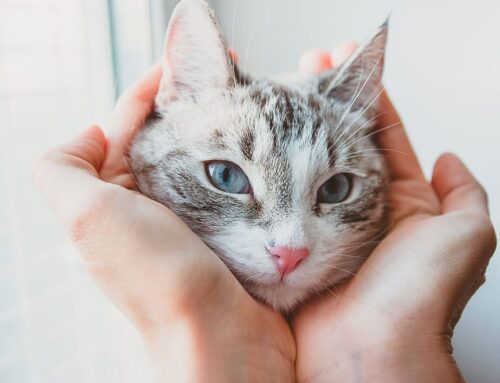Ultrasound is a non-invasive imaging method that can be used to diagnose many conditions and disease processes affecting cats. Our team at Just Cats Clinic wants to provide information on this diagnostic technique, to ensure you know what to expect should an ultrasound be recommended for your cat.
What is veterinary ultrasound?
An ultrasound transducer emits ultrasound waves, and detects the ultrasound echoes reflected back. These ultrasound waves are high frequency sound waves above the human hearing threshold. Usually, the active elements in ultrasound transducers are special ceramic crystal materials called piezoelectrics, which can produce sound waves when an electric field is applied, and can produce an electric field when a sound wave hits. When an ultrasound is performed:
- The transducer, or probe, is placed over the area of interest, directing the sound waves inside the body.
- The sound waves are reflected back to the probe by boundaries between tissues that cross the beam’s path, including the boundaries between fluid and soft tissue, and tissue and bone.
- These echoes return to the transducer, and produce electrical signals that are sent to the scanner, which calculates the distance from the transducer to the tissue boundary.
- This information is used to generate a real-time, two-dimensional image of the tissues and organs.
When is ultrasound recommended for cats and what issues can be diagnosed?
Numerous conditions affecting cats indicate a need for an ultrasound evaluation. These include:
- Heart condition — If your cat has a heart murmur, arrhythmia, or other heart condition signs, an ultrasound of the heart (i.e., an echocardiogram) can help determine the cause of the issue, and the severity of the condition. The most common heart conditions affecting cats involve the heart muscle, and include hypertrophic, restrictive, and dilated cardiomyopathies.
- Pregnancy — An ultrasound can assess fetal viability and development, and can determine the number of fetuses present.
- Abnormal blood test — If your cat’s blood chemistry panel shows elevated kidney or liver enzymes, an abdominal ultrasound may be recommended to assess their kidneys or liver. Hepatic lipidosis is the most common liver disease in cats, and older cats are frequently affected by chronic kidney disease. Other blood test abnormalities may indicate an abdominal mass, which can be visualized on ultrasound.
- Abnormal urinalysis — If your cat’s urinalysis is abnormal, an ultrasound may be recommended to assess their bladder and kidneys, looking for kidney and bladder stones.
- Lameness — If your cat is limping, an ultrasound can evaluate their muscles, ligaments, and tendons, to determine if they have sustained a soft-tissue injury, including:
- Cranial cruciate ligament tear — An injury to a knee ligament
- Palmar carpal ligament breakdown — Ligaments above the front paw tear, or wear down
- Bicipital tenosynovitis — A tendon in the shoulder joint becomes inflamed
- Brachii muscle rupture — A tendon in the upper forelimb ruptures
- Supraspinatus avulsion — The tendon that connects the shoulder to the upper limb ruptures
- Luxating patella — The kneecap is displaced, because the ligaments and tendons are overextended or weakened.
- Endocrinopathies — If your cat has an endocrine issue, such as hyperthyroidism, an ultrasound can assess their thyroid gland.
- Eye trauma — Ultrasonography can be used to evaluate the eye, if damage makes assessing the eye through the cornea difficult.
- Foreign bodies — If your cat ingests a string or other foreign object that cannot be seen on X-ray, an ultrasound can be used to examine the gastrointestinal tract and determine if the issue can be managed medically, or requires surgical intervention.
- Emergencies — In an emergency situation, ultrasonography can be used to assess for internal hemorrhage or pneumothorax, allowing for prompt treatment.
- Sample collection — Ultrasound can be used to collect tissue samples for histological examination. Common methods include ultrasound-guided fine needle aspiration and tru-cut biopsies. Biopsies collected using ultrasound guidance are less invasive than those collected surgically.
What should I expect if my cat needs an ultrasound?

The area that needs the ultrasound will dictate the preparation required for your pet. Considerations include:
- Abdominal ultrasound — Cats undergoing an abdominal ultrasound should be fasted for 12 hours.
- Bladder ultrasound — The bladder is best visualized when full. Therefore, if possible, your cat should not be allowed to urinate for three to six hours before the ultrasound procedure.
- Anesthesia — Anesthesia may be required if biopsies are being performed, or if your cat is uncooperative. They will need to be fasted for 12 hours before the procedure.
- Shaved hair — We will typically shave your cat’s hair overlying the area where the ultrasound will be performed. Ultrasound waves cannot be transmitted through air, so the probe must make complete contact with the skin to obtain a clear and accurate image. Gel is also used to help ensure good contact.
If your cat needs an ultrasound, be assured that this safe, non-invasive procedure can help our veterinary professionals diagnose what is ailing them. If your cat has a condition that you feel may require an ultrasound, do not hesitate to contact our Cat Friendly team at Just Cats Clinic for immediate care, or to schedule an appointment.













